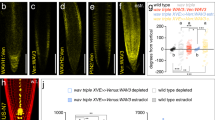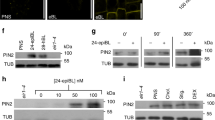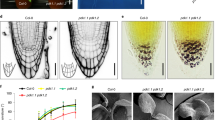Abstract
Polarized cellular distribution of the phytohormone auxin and its carriers is essential for normal plant growth and development. Polar auxin transport 1,2 is maintained by a network of auxin influx (AUX)3 and efflux (PIN)1,2,4,5,6 carriers. Both auxin transport and PIN protein cycling between the plasma membrane and endosomes require the activity of the endosomal GNOM1,2,7,8; however, intracellular routes taken by these carriers remain largely unknown. Here we show that Arabidopsis thaliana SORTING NEXIN 1 (AtSNX1) is involved in the auxin pathway and that PIN2, but not PIN1 or AUX1, is transported through AtSNX1-containing endosomes. We demonstrate that the snx1-null mutant exhibits multiple auxin-related defects and that loss of function of AtSNX1 severely enhances the phenotype of a weak gnom mutant. In root cells, we further show that AtSNX1 localizes to an endosomal compartment distinct from GNOM-containing endosomes, and that PIN2 accumulates in this compartment after treatment with the phosphatidylinositol-3-OH kinase inhibitor wortmannin or after a gravity stimulus. Our data reveal the existence of a novel endosomal compartment involved in PIN2 endocytic sorting and plant development.
This is a preview of subscription content, access via your institution
Access options
Subscribe to this journal
Receive 51 print issues and online access
$199.00 per year
only $3.90 per issue
Buy this article
- Purchase on Springer Link
- Instant access to full article PDF
Prices may be subject to local taxes which are calculated during checkout



Similar content being viewed by others
References
Geldner, N. et al. The Arabidopsis GNOM ARF-GEF mediates endosomal recycling, auxin transport, and auxin-dependent plant growth. Cell 112, 219–230 (2003)
Geldner, N., Friml, J., Stierhof, Y. D., Jürgens, G. & Palme, K. Auxin transport inhibitors block PIN1 cycling and vesicle trafficking. Nature 413, 425–428 (2001)
Swarup, R. et al. Localization of the auxin permease AUX1 suggests two functionally distinct hormone transport pathways operate in the Arabidopsis root apex. Genes Dev. 15, 2648–2653 (2001)
Friml, J., Wiśniewska, J., Benková, E., Mendgen, K. & Palme, K. Lateral relocation of auxin efflux regulator PIN3 mediates tropism in Arabidopsis. Nature 415, 806–809 (2002)
Friml, J. et al. Efflux-dependent auxin gradients establish the apical–basal axis of Arabidopsis. Nature 426, 147–153 (2003)
Petrasek, J. et al. PIN proteins perform a rate-limiting function in cellular auxin efflux. Science 312, 914–918 (2006)
Geldner, N. et al. Partial loss-of-function alleles reveal a role for GNOM in auxin transport-related, post-embryonic development of Arabidopsis. Development 131, 389–400 (2004)
Steinmann, T. et al. Coordinated polar localization of auxin efflux carrier PIN1 by GNOM ARF GEF. Science 286, 316–318 (1999)
Vanoosthuyse, V., Tichtinsky, G., Dumas, C., Gaude, T. & Cock, J. M. Interaction of calmodulin, a sorting nexin and kinase-associated protein phosphatase with the Brassica oleracea S locus receptor kinase. Plant Physiol. 133, 919–929 (2003)
Carlton, J., Bujny, M., Rutherford, A. & Cullen, P. Sorting nexins—unifying trends and new perspectives. Traffic 6, 75–82 (2005)
Campbell, R. E. et al. A monomeric red fluorescent protein. Proc. Natl Acad. Sci. USA 99, 7877–7882 (2002)
Brandizzi, F., Snapp, E. L., Roberts, A. G., Lippincott-Schwartz, J. & Hawes, C. Membrane protein transport between the endoplasmic reticulum and the Golgi in tobacco leaves is energy dependent but cytoskeleton independent: evidence from selective photobleaching. Plant Cell 14, 1293–1309 (2002)
Bassham, D. C., Sanderfoot, A. A., Kovaleva, V., Zheng, H. & Raikhel, N. V. AtVPS45 complex formation at the trans-Golgi network. Mol. Biol. Cell 11, 2251–2265 (2000)
Paciorek, T. et al. Auxin inhibits endocytosis and promotes its own efflux from cells. Nature 435, 1251–1256 (2005)
Ueda, T., Uemura, T., Sato, M. H. & Nakano, A. Functional differentiation of endosomes in Arabidopsis cells. Plant J. 40, 783–789 (2004)
Grebe, M. et al. Arabidopsis sterol endocytosis involves actin-mediated trafficking via ARA6-positive early endosomes. Curr. Biol. 13, 1378–1387 (2003)
Xu, Y., Hortsman, H., Seet, L., Wong, S. H. & Hong, W. SNX3 regulates endosomal function through its PX-domain-mediated interaction with PtdIns(3)P. Nature Cell Biol. 3, 658–666 (2001)
Zhong, Q. et al. Endosomal localization and function of sorting nexin 1. Proc. Natl Acad. Sci. USA 99, 6767–6772 (2002)
Benkova, E. et al. Local, efflux-dependent auxin gradients as a common module for plant organ formation. Cell 115, 591–602 (2003)
Xu, J. & Scheres, B. Dissection of Arabidopsis ADP-RIBOSYLATION FACTOR 1 function in epidermal cell polarity. Plant Cell 17, 525–536 (2005)
Abas, L. et al. Intracellular trafficking and proteolysis of the Arabidopsis auxin-efflux facilitator PIN2 are involved in root gravitropism. Nature Cell Biol. 8, 249–256 (2006)
Swarup, R. et al. Structure–function analysis of the presumptive Arabidopsis auxin permease AUX1. Plant Cell 16, 3069–3083 (2004)
Xu, J. et al. A molecular framework for plant regeneration. Science 311, 385–388 (2006)
Vieten, A. et al. Functional redundancy of PIN proteins is accompanied by auxin-dependent cross-regulation of PIN expression. Development 132, 4521–4531 (2005)
Perret, E., Lakkaraju, A., Deborde, S., Schreiner, R. & Rodriguez-Boulan, E. Evolving endosomes: how many varieties and why? Curr. Opin. Cell Biol. 17, 423–434 (2005)
Alonso, J. M. et al. Genome-wide insertional mutagenesis of Arabidopsis thaliana. Science 301, 653–657 (2003)
Ulmasov, T., Murfett, J., Hagen, G. & Guilfoyle, T. J. Aux/IAA proteins repress expression of reporter genes containing natural and highly active synthetic auxin response elements. Plant Cell 9, 1963–1971 (1997)
Acknowledgements
We thank the Max Planck and SALK Institute for providing the insertion mutant lines. We thank C. Dumas for hosting T.G.'s team in the Reproduction et Développement des Plantes laboratory. We acknowledge A. Chaboud for providing pGIInK::mRFP plasmids; C. Hawes for providing ERD2–GFP and ST-GFP plasmids; T. Guilfoyle for providing the DR5::GUS transgenic line; G. Jurgens for providing gnomB/E mutant and GNOM–GFP lines; J. Friml for supplying the PIN1–GFP line; B. Scheres for the gift of the PIN2–GFP line; M. Bennett for the gift of the AUX1–YFP line and NASC for providing the DR5rev::GFP line. We are grateful to R. Tsien for the gift of mRFP1. We thank C. Scutt for critical reading of the manuscript, N. Paris for helpful discussions and C. Lionnet and F. Simian for technical assistance in confocal microscopy. This work was supported by the Action concertée incitative Biologie du Développement of the French Ministry of Research.
Author information
Authors and Affiliations
Corresponding author
Ethics declarations
Competing interests
Reprints and permissions information is available at www.nature.com/reprints. The authors declare no competing financial interests.
Supplementary information
Supplementary Figure 1
Isolation of the AtSNX1 gene and molecular characterization of snx1mutant.
Supplementary Figure 2
Atsnx1 mutant roots have auxin-related defects.
Supplementary Figure 3
snx1-1 is rescued by transgenic expression of AtSNX1-GFP and AtSNX1-mRFP.
Supplementary Figure 4
Altered DR5::GUS expression in snx1 roots.
Supplementary Figure 5
Genetic interaction between gnomB/E and snx1.
Supplementary Figure 6
AtSNX1-GFP and GNOM-GFP exhibit different sensitivity to Wm.
Supplementary Figure 7
AUX1 is not sensitive to BFA and Wm.
Supplementary Figure 8
Long-term Wm treatment affects AtSNX1-containing endosome morphology.
Supplementary Figure 9
Quantitative effect of different Wortmannin concentrations on primary root elongation.
Supplementary Notes
Includes Supplementary Methods and additional references.
Rights and permissions
About this article
Cite this article
Jaillais, Y., Fobis-Loisy, I., Miège, C. et al. AtSNX1 defines an endosome for auxin-carrier trafficking in Arabidopsis. Nature 443, 106–109 (2006). https://doi.org/10.1038/nature05046
Received:
Accepted:
Published:
Issue Date:
DOI: https://doi.org/10.1038/nature05046
This article is cited by
-
Large-scale analysis of protein crotonylation reveals its diverse functions in Pinellia ternata
BMC Plant Biology (2022)
-
Extracellular vesiculo-tubular structures associated with suberin deposition in plant cell walls
Nature Communications (2022)
-
Multi-scale comparative transcriptome analysis reveals key genes and metabolic reprogramming processes associated with oil palm fruit abscission
BMC Plant Biology (2021)
-
Fluid-phase and membrane markers reveal spatio-temporal dynamics of membrane traffic and repair in the green alga Chara australis
Protoplasma (2021)
-
Proteome and lysine acetylome analysis reveals insights into the molecular mechanism of seed germination in wheat
Scientific Reports (2020)
Comments
By submitting a comment you agree to abide by our Terms and Community Guidelines. If you find something abusive or that does not comply with our terms or guidelines please flag it as inappropriate.



